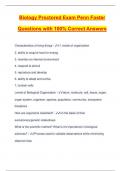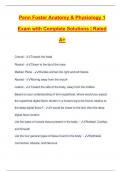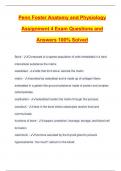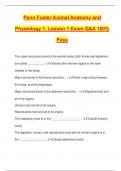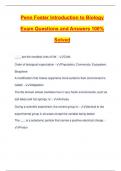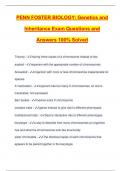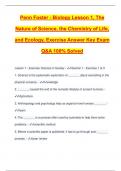Penn Foster
Latest uploads at Penn Foster. Looking for notes at Penn Foster? We have lots of notes, study guides and study notes available for your school.
-
99
- 0
-
8
All courses for Penn Foster
Latest notes & summaries Penn Foster
Biology Proctored Exam Penn Foster Questions with 100% Correct Answers Characteristics of living things - 1. levels of organization 2. ability to acquire food for energy 3. maintain an internal environment 4. respond to stimuli 5. reproduce and develop 6. ability to adapt and evolve 7. contain cells Levels of Biological Organization - atom, molecule, cell, tissue, organ, organ system, organism, species, population, community, ecosystem, biosphere How are organisms classified? - on th...
Penn Foster Anatomy & Physiology 1 Exam with Complete Solutions | Rated A+ Cranial - Toward the head Rostral - Closer to the tip of the nose Median Plane - Divides animal into right and left halves Aborad - Moving away from the mouth Lateral - Toward the side of the body, away from the midline Based on your understanding of term superficial, where would you expect the superficial digital flexor tendon in a horse's leg to be found, relative to the deep digital flexor? - It would be clo...
Penn Foster - Vet Tech - Introduction to Anatomy and Physiology Exam 100% Pass What's the term that describes multiple layers of epithelial cells? - Stratified Epithelium What's the best description of the locations of a cat's paw and shoulder? - The paw is distal to the shoulder Which body cavity contains the heart and the lungs? - Thoracic cavity What are the components of the dorsal body cavity? - The cranial cavity and the spinal cavity Which of the following is the proper way t...
Penn Foster Vet Tech AP1 Chapter 1: Introduction to Anatomy and Physiology Exam Question and Answers 100% Solved Anatomy - Deals with form and structure of the body and its parts - what things look like and where they are located. Physiology - Deals with the functions of the body and its parts- how things work and what they do. Microscopic Anatomy - Deals with microscopic structures such as cells and tissues. Macroscopic/Gross Anatomy - Deals with body parts large enough to be seen su...
Penn Foster Anatomy and Physiology Assignment 4 Exam Questions and Answers 100% Solved Bone - Composed of a sparse population of cells embedded in a hard intercellular substance the matrix. osteoblast - cells that form bone. secrete the matrix matrix - secreted by osteoblast and is made up of collagen fibers embedded in a gelatin-like ground substance made of protein and complex carbohydrates. ossification - osteoblast harden the matrix through this process. canaliculi - slots in the b...
Penn Foster Animal Anatomy and Physiology 1: Lesson 1 Exam Q&A 100% Pass The organ structures found in the ventral cavity, both thorax and abdomen, are called __________. - Viscera (the internal organs in the main cavities of the body) Major structures in the thorax would be... - Heart, major blood vessels, the lungs, and the esophagus. Major structures/tracts of the abdomen would be... - Digestive tract and all of its organs Urinary tract and all of its organs Reproductive tract and ...
Penn Foster Introduction to Biology Exam Questions and Answers 100% Solved ____ are the smallest units of life. - Cells Order of biological organization - Population, Community, Ecosystem, Biosphere A modification that makes organisms more suited to their environment is called: - Adaptation The life domain whose members live in very harsh environments, such as salt lakes and hot springs, is: - Archaea During a scientific experiment, the control group is: - identical to the experimenta...
Penn Foster Biology Book 1 Exam Questions with 100% Correct Answers . In the nineteenth century, what was known about atoms? - The atom determines the chemical property of an element. How does this snake obtain nutrients from corn? - . By eating the lizard Based on this image, what can be inferred about the organization of life? - . Bigger systems build on smaller systems Why are there many niches of species in one mountain? - The elevation changes of the mountain cause different climate...
PENN FOSTER BIOLOGY: Genetics and Inheritance Exam Questions and Answers 100% Solved Trisomy - having three copies of a chromosome instead of two euploid - organism with the appropriate number of chromosomes Aneuploid - organism with more or less chromosomes inappropriate for species X inactivation - organism has too many X chromosomes, so one is inactivated, not expressed Barr bodies - inactive extra X chromosome complex traits - genes interact to give rise to different phenotypes mu...
Penn Foster - Biology Lesson 1, The Nature of Science, the Chemistry of Life, and Ecology, Exercise Answer Key Exam Q&A 100% Solved Lesson 1 - Exercise: Science in Society - Section 1 - Exercise 1 of 3 1. Science is the systematic exploration of _______ about everything in the physical universe. - knowledge 2. _______ caused the end of the nomadic lifestyle of ancient humans. - Agriculture 3. Anthropology and psychology help us organize how humans _______. - learn 4. The _______ is a ...

